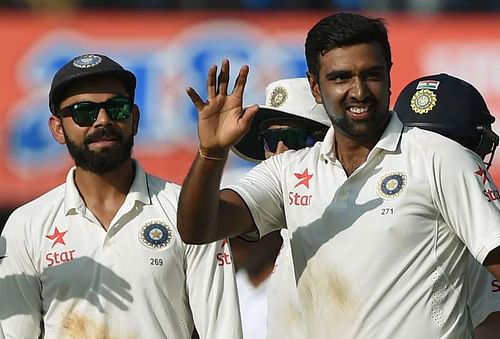
India's DRS conundrum: Finding the right stakeholders involved in opting for DRS
On the final ball of the 102nd over of England's first innings in Mumbai, Ravindra Jadeja skid one off the good length to Jos Buttler, who went back deep in his crease, as the ball hit him on the back pad. Jadeja immediately went up for an appeal. Marius Erasmus thought for a couple of seconds, but then turned down the appeal, gesturing that the ball would have gone down leg.
Jadeja looked confident and instantly turned to skipper Virat Kohli to have a small chat. After a few seconds, Kohli, although tentatively, took the DRS. After the formalities of checking the front foot no-ball and the ultra-edge were completed, the DRS moved to the ball-tracker.
Less than 50% of the delivery would have clipped the leg-stump, making the third umpire stay with the original on-field call of not out. India lost their second DRS, with still 60 more overs to go before they got two more chances to opt for it again.
Also read: Alastair Cook must lead from the front and rediscover resolve to bounce back
The England series is the first time India is using the DRS in Test cricket since 2008. The concept of DRS is still novel to them, and considering that, Kohli’s men have done a fine job at getting a major percentage of DRS calls correct.
But having said that, India are still making a few gaffes that could be rectified if they can make a few basic adjustments in how they opt for the review system.
Firstly, India isn't sure about who should be the right person to take the DRS call. On most occasions, it is a task decided between the bowlers and the captain. Most of the times, we can see Ravichandran Ashwin or Jadeja turning to Kohli immediately after they believe the batsman is out but has been given not out by the umpire.
Now, there are a couple of issues when the decision to opt for the DRS stays only with the captain and the bowler, without consulting other key stakeholders involved in the process - the wicket-keeper and the short-leg fielder.
As a bowler, you are almost always certain that the batsman is out. It’s just how every bowler in the world is tuned. They toil for hours under unresponsible conditions, so whenever the batsman edges the ball or gets hit on his pads, they believe it’s out.
Secondly, the captain, at times, isn’t in the best of fielding positions to ascertain the closeness of the appeal made. On most occasions for India, Kohli is standing at slips or the cover position, and not always will he get the best possible view of the delivery.
The wicket-keeper is one of the most important elements during close calls. Firstly, he is closest to the batsman and is the best person to hear the faint outside edges. Secondly, wicket-keepers are trained to track the trajectory of the ball. Their gloves move as the delivery releases the bowler’s hand, in pursuit to catch the ball, in case the batsman misses or edges it. In fact, the wicket-keeper is the human version of the ball-tracking technology.
All throughout the England series, there hasn't been an instance when the bowler or captain went to the wicket-keeper first - Wriddhiman Saha earlier and Parthiv Patel later. In fact, when Jayant Yadav got his first Test wicket, he did not want to opt for the DRS, but only after Saha suggested that the batsman might be out, that he went for it.
Another essential and often underrated member who can play a key role in opting for the DRS is the short-leg fielder. A short-leg fielder, given his position, can very well tell how far or back the batsman has moved in his crease. On calls where the height of impact is the matter of concern, the short-leg fielder should be the go-to man.
But this isn't easy in a country likes India. In India, there is a rudimentary cultural problem, that is not just specific to cricket, and is hindering them in making the best use of the DRS. In our culture, opposing or countering your seniors can come off as disrespectful. We are brought up with the belief ingrained deeply into us to respect, and never disagree with our seniors.
So when Kohli thinks that the batsman is out, the keeper Saha or a Karun Nair, standing at short leg, may think twice before going to his captain and telling him that the batsman might not be out on this occasion. This becomes all the more difficult when you have just 10 to 15 seconds to decide whether to opt for the DRS or not.
India is missing a major trick when it comes to deciding whether to opt of DRS or not. But Kohli, as captain, has time and against mentioned that he wants to inculcate a culture of strong friendship in his side, while letting his troupes express themselves freely on the field.
Kohli is also a quick learner to not realise the mistakes he has made while opting the DRS . Going forward, if the Indian skipper can make these minor adjustments in his captaincy, it will help his side to better the number of decisions they get right using the DRS.
For all the latest in the world of Cricket, bookmark Sportskeeda Cricket
